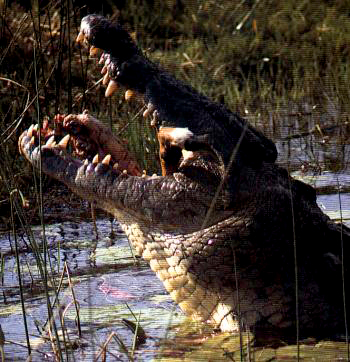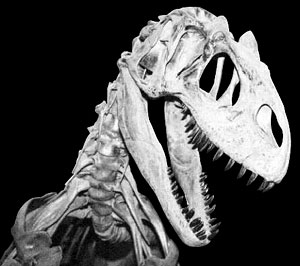
Who ate who. From NationalGeographic.com
Rare is the event when the fossil record records a case of animal behaviour. More often than not, this is recorded as footprints. Every once in a while though, we get lucky and find a case of actual animals doing what they were doing prior to death.The most famous case of this is the fighting dinosaurs of Mongolia. This is the fossil featuring a Protoceratops andrewsi attacking and being attacked by a Velociraptor mongoliensis. This was easily the best fossil of this type that scientists had ever found. That is until now.
First Food Chain Fossil.
Paleontologists at the Berlin museum of natural history have unearthed the remains of a a fossil “shark” that ate an “amphibian” that ate a fish.
The reason for all the quotation marks is due to the fact that all three of these critters represent animals that no longer exist, and were not true members of Selachimorpha (sharks), Amphibia, or osteichthys. The “shark” that was found, was a xenacanthid. This makes it a cartilaginous fish (Chondrychthys), but it’s no more a shark than it is a skate, or a ray. The other animal (well animals, since there were two that were eaten) were temnospondyls. Temnospondyls were a highly successful group of critters that hold the distinction of being one of the first land dwelling tetrapods (think: Eryops). Whether, or not they can be considered amphibians, seems to depend on how far back in time one is willing to call critters amphibians. In the very simplified evolutionary view of life (i.e. classic cartoon version), then yes, any animal between a fish and a reptile is going to be an amphibian. In the more complicated, bushy version of evolution (i.e. what actually happened) calling temnospondyls amphibians gets kind of weird. For instance, temnospondyls apparently had dermal scales, much like fish. Scales are nonexistent in extant amphibians (save caecililans, so maybe this isn’t so weird), so calling temnospondyls amphibians doesn’t really sit well with me. Then again, if I were a science journalist, I’d have to figure out how to explain temnospondyls to a lay public, and to do it with a finite amount of space.
But I digress…
Along with the two temnospondyls in the stomach of the xenacanthid “shark,” we also have a “fish” inside one of the temnospondyls. Okay, so “fish” has been a wastebin term for some time now. As such, one could technically say that it is okay to call the animal inside the temnospondyl, a fish. I’d just point out that the fish that was eaten, was an acanthodian. These were an interesting, but enigmatic group of earlly fish that broke off from the line that lead to the osteichthyans. They weren’t cartilaginous fish, but they didn’t give rise to anything alive today either.
The reason this fossil rocks (no pun intended) is because it shows one animal eating another animal, and then getting eaten by yet another animal. It reminds me of an old Looney Tunes cartoon. This tri-level trophic event is rare to see in living creatures, so one can imagine the chances for a one in a million fossil. Making matters even more interesting, this tri-level trophci event involves groups of animals that aren’t alive today. It’s a true snapshot of a bygone time.
Completely awesome find.
For those looking to read more about it, I’ve included the abstract to the official paper:
Kriwet, J., Witzmann, F., Klug, S., Heidtke, H.J. 2007. First direct evidence of a vertebrate three-level trophic chain in the fossil record. Proc. Royal Soc. B. Early published online. doi: 10.1098/rspb.2007.1170
Abstract
We describe the first known occurrence of a Permian shark specimen preserving two temnospondyl amphibians in its digestive tract as well as the remains of an acanthodian fish, which was ingested by one of the temnospondyls. This exceptional find provides for the first time direct evidence of a vertebrate three-level food chain in the fossil record with the simultaneous preservation of three trophic levels. Our analysis shows that small-sized Lower Permian xenacanthid sharks of the genus Triodus preyed on larval piscivorous amphibians. The recorded trophic interaction can be explained by the adaptation of certain xenacanthids to fully freshwater environments and the fact that in these same environments, large temnospondyls occupied the niche of modern crocodiles. This unique faunal association has not been documented after the Permian and Triassic. Therefore, this Palaeozoic three-level food chain provides strong and independent support for changes in aquatic trophic chain structures through time.







